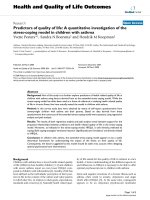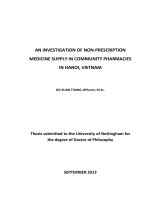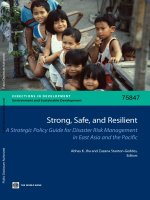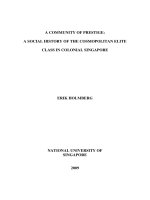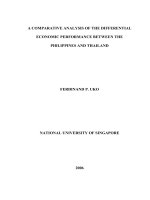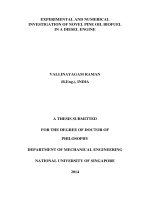A genre investigation of higher degree research proposals in english language and english literature
Bạn đang xem bản rút gọn của tài liệu. Xem và tải ngay bản đầy đủ của tài liệu tại đây (605.71 KB, 161 trang )
A GENRE INVESTIGATION OF
HIGHER DEGREE RESEARCH PROPOSALS IN
ENGLISH LANGUAGE AND ENGLISH LITERATURE
YIN BIN
(BA, GRADUATE DIP)
A THESIS SUBMITTED
FOR THE DEGREE OF MASTER OF ARTS
DEPARTMENT OF ENGLISH LANGUAGE AND LITERATURE
NATIONAL UNIVERSITY OF SINGAPORE
2006
ii
ACKNOWLEDGEMENTS
I would like to thank the following individuals for their guidance and assistance
during my MA research and thesis writing:
-My supervisor, Dr. Sunita Abraham, for her most invaluable guidance and timely
feedback during the whole process and for being a model of efficiency that I strive to
emulate
-All participants in my research, including six graduate students and two faculty
members, for providing the data, without which this study could never have begun
-My parents and aunts (maternal side), for their love.
My thanks also go to the National University of Singapore for their generous financial
support.
iii
TABLE OF CONTENTS
ACKNOWLEDGEMENTS ii
TABLE OF CONTENTS iii
SUMMARY v
LIST OF TABLES vii
LIST OF FIGURES viii
Chapter One 1
INTRODUCTION 1
1.1 INTRODUCTION 1
1.2 THE IMPORTANCE OF ACADEMIC DISCOURSE 1
1.3 GENRE APPROACH TO ACADEMIC DISCOURSE 3
1.4 THE RESEARCH PROPOSAL: AN OCCLUDED GENRE 6
1.5 OBJECTIVES AND SIGNIFICANCE OF THIS RESEARCH 7
1.6 ORGANIZATION OF THE THESIS 9
Chapter Two 10
LITERATURE REVIEW 10
2.1 INTRODUCTION 10
2.2 THE CONCEPT OF GENRE 11
2.3 GENRE AS SOCIAL ACTION 12
2.4 GENRE AS TEXT 16
2.5 EXISTING RESEARCH ON PUBLISHED GENRES (RA) 19
2.6 THE PLURALITY OF A GENRE SYSTEM 23
2.7 RESEARCH PROCESS GENRES 23
2.8 EXISTING RESEARCH ON RESEARCH PROPOSALS 25
2.9 CONCLUSION 30
Chapter Three 32
METHODOLOGY 32
3.1 INTRODUCTION 32
3.2 DATA 32
3.2.1 Textual data 33
3.2.2 Interview data 35
3.2.3 The institutional role of the research proposal 36
3.3 ANALYTICAL FRAMEWORK 38
3.4 CONCLUSION 42
Chapter Four 44
ANALYSIS OF LANGUAGE RESEARCH PROPOSALS 44
4.1 INTRODUCTION 44
4.2 OVERVIEW OF MOVES IN THE LANGUAGE PROPOSALS 44
4.3 ESTABLISHING A TERRITORY 51
4.3.1 Claiming centrality 51
4.3.2 Making topic generalizations 52
4.3.3 Reviewing items of previous research 54
4.3.4 Stating personal interest 56
4.4 ESTABLISHING A NICHE 60
iv
4.5 OCCUPYING THE NICHE 62
4.5.1 Outlining purposes 63
4.5.2 Spelling out contribution/significance of proposed research 65
4.6 ESTABLISHING THEORETICAL BASIS 68
4.7 SPELLING OUT METHODOLOGY 69
4.8 ACHIEVING CLOSURE 74
4.9 CONCLUSION 77
Chapter Five 80
ANALYSIS OF LITERATURE RESEARCH PROPOSALS 80
5.1 INTRODUCTION 80
5.2 OVERVIEW OF MOVES IN THE LITERATURE PROPOSALS 80
5.3 ESTABLISHING A TERRITORY 87
5.3.1 Claiming centrality 88
5.3.2 Making topic generalizations 89
5.3.3 Reviewing items of previous research 90
5.3.4 Sketching out contextual background 92
5.4 ESTABLISHING A NICHE 93
5.4.1 Problem raising 94
5.4.2 Indicating a gap 96
5.5 OCCUPYING THE NICHE 97
5.5.1 Outlining purposes 98
5.5.2 Stating thesis 100
5.5.3 Outlining structure of proposed thesis 101
5.6 RELATING PAST EXPERIENCE TO PROPOSED PROGRAM 102
5.7 ADVANCING INTERPRETATION OF RELEVANT THEME 103
5.7.1 Introducing theme 104
5.7.2 Indicating reading strategy 105
5.7.3 Reviewing literature related to theme 106
5.7.4 Announcing own interpretation of theme 107
5.7.5 Offering detailed analysis of theme 109
5.8 CONCLUSION 111
Chapter Six 113
CONCLUSION 113
6.1 INTRODUCTION 113
6.2 KEY FINDINGS 113
6.3 PEDAGOGICAL IMPLICATIONS 117
6.4 LIMITATIONS AND SUGGESTIONS FOR FUTURE RESEARCH 118
APPENDIX ONE 119
SAMPLE ANALYSIS OF LANGUAGE PROPOSAL 119
APPENDIX TWO 129
SAMPLE ANALYSIS OF LITERATURE PROPOSAL 129
APPENDIX THREE 142
INTERVIEW WITH LANGUAGE FACULTY MEMBER 142
APPENDIX FOUR 144
INTERVIEW WITH LITERATURE FACULTY MEMBER 144
REFERENCES 146
v
SUMMARY
This exploratory study investigates the rhetorical structure of higher degree research
proposals in English Language and English Literature, informed by Swales’ (1990)
genre analysis framework. Despite the abundance of literature on academic genres
like the research article and the thesis, not much is known about higher degree
research proposals, which Swales (1996) identifies as an occluded genre.
The purpose of this study was to try and provide a thick description of the higher
degree research proposal as an academic genre, using both textual analysis and
ethnographic data. Six research proposals, written by successful applicants to higher
degree programs in language studies and literary studies at a Singapore-based
university, were analyzed in terms of their rhetorical move structure. This analysis
was complemented by interviews with the proposal writers and two faculty members,
one from each discipline, to elicit contextual factors like intended readership,
authorial positioning, and institutional expectations affecting the production and
reception of this genre.
Although no overall Move sequence was observed across the proposals, some
Moves/Strategies tended to follow loose trends. For example, in both the language
and literature proposals, Move 3 tends to occur after Move 2 to form a slot-and-filler
relationship, as has been observed elsewhere.
The absence of a rigid Move sequence notwithstanding, the rhetorical structuring and
the realization of Moves was visibly shaped by such factors as communicative
purpose and disciplinary predisposition. One important rhetorical purpose of writing a
vi
research proposal is to convey the image of a competent researcher. Textually, this
purpose seems to be realized by the rhetorical prominence assigned to Move 1, among
others, where authors demonstrate their familiarity with the current state of art in the
field, and Move 3, where the authors put forward their own research objectives, both
of which are qualities valued in academic communities. In addition, Move 4 in
literature proposals (Relating past experience to proposed program) also showcases
the authors’ research ability by highlighting prior research experience, thus
buttressing the image of a competent researcher.
Disciplinary proclivity (roughly conceptualized as the concerns of the (sub)-field and
mode of inquiry) exerts influence on rhetorical structuring as well. For instance, all
the language proposals instantiate the ‘Spelling out Methodology’ Move, thus
reflecting the importance of having a clear methodology in language research,
whereas this Move is absent in the literary studies proposals. Similarly, the
disciplinary concerns of educational phonology, a field represented in one of the three
language proposals, translate into corresponding rhetorical strategies where gaps in
the real world are indicated and potential significance of the proposed research to real
world issues is stated, in addition to gaps in and significance to the research world. On
the other hand, literature proposals instantiate a Move where interpretation of literary
themes is advanced, reflecting literary studies as an interpretation-driven field.
vii
LIST OF TABLES
Table 1: Information on research proposals and their writers 35
Table 2: Moves and relative textual space across three language proposals 46
Table 3: Moves and relative textual space across three literature proposals 82
viii
LIST OF FIGURES
Figure 1: Swales' CARS model 20
Figure 2: Swales' CARS model 39
Figure 3: Move sequence of LAN 1 47
Figure 4: Move sequence of LAN 2 48
Figure 5: Move sequence of LAN 3 49
Figure 6: Move sequence of LIT 1 83
Figure 7: Move sequence of LIT 2 84
Figure 8: Move sequence in LIT 3 86
1
CHAPTER ONE
INTRODUCTION
1.1 INTRODUCTION
This study investigates an occluded genre: higher degree research proposals in
English Language and English Literature in the hope of arriving at a thick description
of research proposals as a genre, and shedding light on possible disciplinary variations
in this particular genre of academic discourse. More specifically, this study seeks to
account for the rhetorical structure of the higher degree research proposal in terms of
its communicative purpose, institutional expectations and represented disciplinary
culture. This chapter briefly introduces the notions relevant to this study. Section 1.2
discusses the importance of written discourse in academic settings. Section 1.3 offers
a brief sketch of contemporary genre approaches to academic discourse and briefly
reviews relevant research on genre analysis of academic discourse. Section 1.4 argues
for the importance of investigating the higher degree research proposal as an instance
of occluded genre, while Section 1.5 spells out the objectives and significance of this
study. The final section (1.6) outlines the organization of the thesis as a whole.
1.2 THE IMPORTANCE OF ACADEMIC DISCOURSE
The study of academic discourse in its various aspects has attracted much attention in
genre analysis over the past few decades. A consensus held by genre analysts is that
understanding discourse is essential to understanding disciplinary culture (Hyland,
2000). Hyland (2000) provides two reasons for the importance of academic discourse
in discourse communities. One is the constitutive power of disciplinary discourse, that
2
is, “writing is not just another aspect of what goes on in the disciplines, it is seen as
producing them” (Hyland, 2000:3). Bazerman makes a similar observation about the
constitutive role that writing plays in the professional world:
…everything that bears on the professions bears on professional writing. Indeed,
within the professions, writing draws on all the professional resources, wends its
way among the many constraints, structures, and dynamics that define the
professional realm and instantiates professional work. (Bazerman, 1993: vii)
A related reason for the importance of academic discourse is the fact that writing is
the quintessential channel whereby academics communicate. Established members of
a discourse community who are spokespersons for the values and discursive practices
of the discipline frequently publish their research in journals, books, reviews, and
conference papers, all exemplars of written genres. Faculty members also engage in
many service and administrative written genres such as class visitation reports and
curriculum documents (Hyon and Chen, 2004).
Given the currency of written discourse in academia, the study of academic discourse
has flourished in composition studies and applied linguistics, to make explicit the
values upheld and practices endorsed in various academic communities (Samraj,
2004). The genres that have been investigated include published texts, such as the
much valorized research article (e.g. Swales 1990; Yang 2001; Bret 1994; Hyland
2001), student research papers (Samraj, 2004), dissertations (Hopkins & Dudley-
Evans, 1988), experimental reports (Buker, 1990), data commentaries, research
reports, abstracts and posters (Swales & Feak 1994, 2000). However, the higher
degree research proposal as an instance of “occluded genre” (Swales, 1996) has rarely
been looked into, partly due to the lack of access to this type of texts. Nonetheless, the
importance of the research proposal as a means to gauge the competence of students
3
and as a part of the gate-keeping role in academic communities to select future players
in the academic world is clear. In the next few sections, I look in more detail at
contemporary genre analysis of academic discourse, and in doing so, argue for the
importance of examining the higher degree research proposal as a genre.
1.3 GENRE APPROACH TO ACADEMIC DISCOURSE
Genre is a well researched concept in various disciplines, ranging from folklore
studies to applied linguistics (Yang, 2001). The term was originally used to refer to
different text types in the categorization of literary texts. In non-literary discourse,
genre refers to socially recognized ways of using language. It revolves around the
belief that writing is produced with the writer’s awareness of the purpose of the text
and the intended audience (Hyland, 2003). As Bhatia (2002: 22) pithily puts it, genre
analysis of discourse is “the study of situated linguistic behavior in institutionalized
academic or professional settings”.
Directly pertinent to the analysis of academic discourse are three overlapping strands
of genre studies, with different emphases. The systemic functional linguistics (SFL)
tradition views genre in terms of the context of culture which informs the lexico-
grammatical choices and schematic structure of texts while the new rhetoric tradition
emphasizes the regularities of staged, goal oriented social process (Berkenkotter and
Huckin, 1995) that the genre aims to achieve. English for Specific Purposes (ESP) in
turn is concerned specifically with academic and professional discourse. This strand
of research regards genre as “class of communicative events, the members of which
share some set of communicative purposes” (Swales, 1990: 58). Despite differences
in perspective, the three schools of thinking are united by a common attempt to
4
describe and explain genres in academic/professional settings with the understanding
that the purpose and the context of writing shape discourse in important ways,
whether in terms of surface linguistic features or structural regularities. The literature
is rich in the analysis of the various academic genres such as graduate seminars, PhD
thesis, lab reports, and most importantly, published genres such as the research article.
The different facets of the academic genres, be it surface linguistic features, context of
culture or rhetorical structure, have been well documented.
Studies which focus on the surface linguistic features of academic discourse includes
the examination of hedging, modality and reporting verbs (Hyland, 1996; Salager-
Meyer, 1992; Thompson & Ye, 1991), metadiscourse in L2 postgraduate student
writing (Hyland, 2004), and lexical verbs used in medical research articles (Williams,
1996). Other researchers are chiefly concerned with the institutional context
surrounding the genre and the social action the genre aims to achieve (e.g. Bazerman,
1988; Berkenkotter & Huckin, 1995; Rymer, 1988).
The bulk of research in genre analysis, however, deals with the patterns of rhetorical
organization in academic genres in various disciplines, especially in the ESP genre
tradition. The rhetorical organization of a text is described as being made up of series
of rhetorical “moves”, defined as a segment of text that is shaped and constrained by a
specific communicative function (Holmes, 1997). Within each move there are one or
more further realizations known as steps or strategies. Prior work along this line
include studies of the introduction sections of research articles (Swales, 1981, 1990;
Swales and Najjar, 1987; Chin, 1993 and Yang, 2001); the results sections of research
articles (Hopkins and Dudley-Evans, 1988; Brett, 1994); the introduction and
5
discussion sections of dissertations (Dudley-Evans, 1986); popularized medical texts
(Nwogu, 1991), abstracts (Salager-Meyer, 1992); and job application and sales
promotion letters (Bhatia, 1993).
My own study is chiefly concerned with describing the textual aspect of genre and
explaining textual organization in terms of communicative purpose and institutional
constraints on the genre. This integrated approach is adopted, based on the
understanding that text is dependent on context for its creation and consumption.
Therefore, to fully understand the rhetorical features of a text, it is important to
complement textual analysis with contextual analysis. On the necessity of
investigating contextual aspects of genre, Swales (1993: 691) notes, “when we deal
with individual texts (or clusters of them), we ignore investigating context of situation
and context of culture at some peril”.
The academic genre that has been given extensive attention in genre analysis is the
research article (Yang and Allison, 2003). There are two reasons why this is so. The
first has to do with access. Research articles are published texts and are easily
accessible to genre researchers. The second and perhaps more important reason has to
do with the important role the research article plays in academic communities where it
is regarded as the vehicle of knowledge production and transmission. As noted by
Hyland (2000:1) on the research article, “these (published) texts are the lifeblood of
the academy as it is through the public discourse of their members that disciplines
authenticate knowledge, establish their hierarchies and reward systems, and maintain
their cultural authority…”. It seems natural therefore for genre analysts to try and
6
fully account for the research article to make explicit the disciplinary and discursive
practices endorsed in academic communities.
Bhatia (2002: 31) however, points out the plurality of genres in any discipline,
observing that a generic system in a discipline typically comprises “…sets of genres
associated with each discipline…(which)…are rather distinct in terms of their generic
integrity, textual and rhetorical characterizations”. To fully understand a discourse
community’s endorsed values and practices, genre research needs to extend beyond
published research articles to those other genres that also figure in the production of
disciplinary knowledge.
1.4 THE RESEARCH PROPOSAL: AN OCCLUDED GENRE
One important academic genre that has not been given due attention is the higher
degree research proposal (Swales 1996). It is categorized by Swales (1996) as one
form of research process genre. Swales (1996: 46) defines research process genres as
those that “operate to support and validate the manufacture of knowledge directly in
the aspect of the publishing process itself, or indirectly by underpinning the academic
administrative process of hiring, promotion and departmental review”. Genres of this
type manifest two characteristics. According to Swales (1996: 46), on one hand, “…
they are typically formal documents which remain on file…They are written for
specific individuals or small-group audiences, and (on the other hand, they) may also
be seriously invested with demonstrated scholarship and seriously concerned with
representing their authors in a favorable professional light”. The most fascinating
aspect about process genre is the fact that “exemplars of these genres are typically
hidden, “out of sight” or “occluded” from public gaze by a veil of confidentiality”
7
(Swales, 1996: 46). The occluded nature of research proposals partially accounts for
the fact that this genre is relatively under-researched. Apart from a few accounts of
related genres such as grant research proposals written by established researchers
(Connor & Mauranen 1999; Connor 2000, Myers 1990), studies of the higher degree
research proposal as a genre are practically non-existent, to the best of my knowledge.
I would argue that it is important to understand this genre both for theoretical and
pedagogical reasons. Besides being part of a genre system that embodies and
constitutes a discipline’s culture, research proposals serve an important gate-keeping
role in higher research degree admission. The research proposal conveys to the
admission board the interest of the student and more importantly the extent to which
s/he is prepared to undertake research in an area of interest. However, because the
requirements for this genre are usually implicit, student applicants may have
difficulties in matching the expectations of their targeted audience. This is especially
so for students writing across linguistic and cultural boundaries, and who could
therefore benefit from the findings of research into this occluded genre.
1.5 OBJECTIVES AND SIGNIFICANCE OF THIS RESEARCH
This research intends to investigate higher degree research proposals submitted by
students applying for admission to a research degree program in a Singapore-based
university. The objective of the research is to describe the rhetorical structure of the
research proposals, how it relates to the communicative purposes and the expectations
of the institutional context; and, how the above facets may vary along disciplinary
lines. According to Allison (2002: 173), the overall communicative purpose of the
research proposal is to “convince potential supervisors and other academics, who have
8
the power and responsibility to make recommendations to a university about which
research student to admit”. Informed by current understandings of genre theory which
stress the relationship between text and context (Bhatia, 1993; Swales, 1990), this
study combines textual analysis of research proposals (rhetorical moves) with
interview data from faculty members as well as the authors of the proposals in order
to arrive at a “thick” account of the research proposal genre in English Language and
English Literature studies in a specific academic setting. Hopefully, this research will
yield interesting findings about the research proposal as a genre in terms of its
rhetorical structure and shed light on the different disciplinary cultures manifested in
the genres, thereby serving as a starting point for further work on this genre.
On a more practical plane, this genre-based research is also expected to have
pedagogical implications. Generic knowledge is crucial for initiation into discourse
communities (Bhatia, 1997). Awareness of genre knowledge is crucial in assisting
students to make informed choices when they engage in genre production (Allison,
2002; Hyland, 2003). According to Berkenkotter and Huckin (1995), students are
known as “legitimate peripheral participants” in the academic community. Yet, they
may not be aware of specific genre constraints when they compose a proposal for
research degree admission. This is especially true for those students identified in
Allison et al (1998) whose first language is not English, but nonetheless have to meet
the expectations of English medium discourse communities. Insofar as genres have
been found to vary across linguistic and cultural communities (e.g. Connor, 1996;
Samraj, 2005b), the excavation of discursive practices in English medium discourse
communities will assist non-native English speaking students in their acculturation
into such discourse communities. It is therefore hoped that the identification of the
9
generic structure of research proposals in each specific discipline (English Language
and English Literature) and of faculty members’ expectations of this genre will aid
future student researchers as well as English for Academic Purposes (EAP)
practitioners in their learning and teaching practices. Although the research will be
specific to a local discourse community, the findings may have wider relevance for
students in other settings.
1.6 ORGANIZATION OF THE THESIS
Chapter one of this thesis has argued for the importance of studying academic
discourse in general and the higher degree research proposal, in particular. The genre
approach to academic discourse has also been introduced, as was the overall objective
of this study. Chapter two presents a more detailed overview of the important
concepts introduced in the first chapter, and reviews the existing literature in order to
position this research intellectually in the field of genre analysis. Chapter three
introduces the methodology of the study, as well as a discussion of Swales’ CARS
(Creating a Research Space) model in light of the overall purpose of this study.
Chapters four and five, the key chapters of this thesis, present the results and
discussion of the analysis of research proposals in English Language and English
Literature, respectively. Chapter six concludes the thesis by comparing the results in
chapters four and five, summarizing the overall findings of the study, and highlighting
the limitations of the present study as well as future research directions.
10
CHAPTER TWO
LITERATURE REVIEW
2.1 INTRODUCTION
The study of scientific language has long held the attention of scholars partly due to
the awe and wonder with which scientific knowledge is regarded by both academics
and laypersons alike (Chin, 1993). Coupled with this intrinsic fascination with
scientific language is the remarkable rise of English as a global research language
(Swales, 1990; Kanoksilapatham, 2005) and the consequent homogenization in the
way scholars communicate. The study of English academic discourse constitutes a
worthy field of enquiry, since it has relevance to a global academic community united
by a common language and shared agenda.
A useful analytical framework for academic discourse is genre analysis which stresses
the relationship between the text and its social milieu as integral to the understanding
of discourse (Cadman, 2002). Such an approach to academic texts assists us in
achieving a better understanding of academic discourse. The literature is rich in
research done into various types of academic genres such as research articles (e.g.
Swales, 1990), Masters and PhD theses (Dudley-Evans, 1986; Bunton, 2002), and
student written research papers (Samraj, 2004), just to name a few, although, as
indicated in Section 2.7, certain genres labeled “occluded genres” are not very well
documented in the literature. This chapter sets out to present an overview of the
current theories and existing research in genres studies so as to provide the relevant
theoretical background against which this study is carried out. Section 2.2 presents a
brief sketch of the contemporary understanding of the concept of genre. Sections 2.3
11
and 2.4 approach the discussion of genre from its two related aspects: Genre as social
action and Genre as text. After this review of theory, Section 2.5 looks at existing
literature on the research article, while sections 2.6-2.7 argue for the importance of
investigating occluded, non-published genres in general and the higher degree
research proposal in particular. Section 2.8 follows up with a review of existing
literature on this particular type of academic text, and discusses how my research
differs from these existing studies.
2.2 THE CONCEPT OF GENRE
The term genre prototypically refers to “a distinctive type or category of literary
composition” (Swales, 1990:33). However, such a definition can no longer adequately
capture the expanded meanings that the term encapsulates today. According to Swales
(1990), “genre” today refers to “a distinctive category of discourse of any type,
spoken or written, with or without literary aspirations”. Therefore, lectures, court
interrogations, newspaper articles and grant proposals all constitute instances of genre
in its contemporary sense.
Genre is a well-researched topic in numerous disciplines. The study of genre ranges
across such varied fields as folklore studies (Rohrich, 1991; Oring, 1986), literary
studies (Fowler, 1982), rhetorical studies (e.g. Miller, 1984; Campell and Jamieson,
1978), linguistic anthropology (e.g. Stocking 1974) , the sociology of language (e.g.
Bergmann and Luckmann, 1995) , linguistics (e.g. Hymes, 1972, 1974; Saville-Troike,
1982) and applied linguistics (e.g. Berkenkotter and Huckin, 1995; Halliday and
Hasan, 1985; Martin, 1989; Swales, 1990). I shall not attempt a detailed delineation of
how the notion genre is viewed and applied in these various fields. Rather, given the
12
focus of this study, I discuss only the applied linguistics perspective on genre. The
applied linguistics genre approach itself, however, is not a strictly monolithic one. It is
currently agreed that there are at least three different, though overlapping, strands of
genre studies in applied linguistics (Paltridge,1997; Yang, 2001; Hyon, 1996). These
three strands are: Systemic Functional Linguistics (SFL), New Rhetoric, and English
for Specific Purposes (ESP). Differences in conceptualization and focus
notwithstanding, the three strands of genre theory share the belief that genre
comprises both a social plane and a verbal plane and that the dialectical relationship
between discourse and social context is a precondition to a thorough understanding of
texts (Cadman 2002). Below, I offer a brief review of the theories and research in
genre analysis to provide an understanding of contemporary genre theory relevant to
my study. In the review, genre is approached from two aspects: genre as social action
and genre as text. This division has been made largely for ease of organization and
discussion, but should not mask the true spirit of an integrated genre theory, i.e. that
the two aspects are essentially inter-related for the production and consumption of
genre as socially situated textual practices.
2.3 GENRE AS SOCIAL ACTION
The social and contextual aspects of genre are explicitly emphasized in contemporary
genre theories. New rhetoric, a strand of genre theory influenced by poststructuralism,
rhetoric and first language composition (Hyland, 2003), conceptualizes genre as the
social action that discourse intends to achieve (Berkenkotter and Huckin, 1995). In
Miller’s (1984: 151) words, genre is defined, not in terms of “the substance or the
form of discourse but the action it is used to accomplish”. Related to the notion of
discourse as social action, is the dynamic nature of genre. That genre is constantly
13
changing in response to dynamic social contexts is widely embraced by the new
rhetoric genre experts. However, genre analysts also concur about the relative stability
of genre at a specific site at a specific moment. As eloquently stated by Schryer (1993:
208) , genre could be described as a “stabilized-for-now or stabilized enough site of
social action and ideological action”. Or, as Yang (2001: 27) puts it, “the recognition
of the stable aspect of genre makes the research activities of investigating generic
features meaningful. The dynamic aspect of genre implies that no research results can
completely capture the characteristics of a genre”. The new rhetoric genre studies
provide rich descriptions of the social context or institutional constraints on the genre.
Representative research in new rhetoric genre studies includes Bazerman (1988),
Bizzell (1992), and Miller (1984).
That social action is an important element of genre is equally emphasized in the
Systemic Functional Linguistics (SFL) approach to genre. SFL experts define genre as
“the staged purposeful social activity through which a culture is realized in a
language” (Martin and Rothery, 1986: 243). Genre in this tradition is conceptualized
at the level of “context of culture” as opposed to “context of situation”. According to
Halliday and Hasan (1985), context of situation refers to the immediate environment
of the text, while the context of culture is the broader background against which the
text has to be interpreted. The “context of culture” constitutes genre, while the
“context of situation” realizes register. Couture (1986, cited in Swales, 1990: 41)
provides a very clear classification of the two concepts: “Registers impose constraints
at the linguistic level of vocabulary and syntax, whereas genre constraints operate at
the level of discourse structure.” It is the cultural conditions operating on the
production of texts that constitutes the social aspect of genre in SFL.
14
English for Specific Purposes (ESP) is a third strand of genre theory rich in social
consideration of texts. Specifically, ESP genre analysts see genre as a class of
structured communicative events employed by specific discourse communities whose
members share broad social purposes (Swales, 1990: 45-47). Swales (1990) provides
a provisional definition of genre in ESP that so far most eloquently captures the social
essence of this concept:
A genre comprises a class of communicative events, the members of which share
some set of communicative purposes. These purposes are recognized by the expert
members of the parent discourse community and thereby constitute the rationale
for the genre. This rationale shapes the schematic structure of the discourse and
influences and constrains choice of content and style. Communicative purpose is
both a privileged criterion and one that operates to keep the scope of a genre as
here conceived narrowly focused on comparable rhetorical action. In addition to
purpose, exemplars of a genre exhibit various patterns of similarity in terms of
structure, style, content and intended audience. If all high probability expectations
are realized, the exemplar will be viewed as a prototypical by the parent discourse
community. The genre names inherited and produced by discourse communities
and imported by others constitute valuable ethnographic communication, but
typically need further validation. (Swales, 1990:58)
Two centrally important notions of this definition of genre are communicative
purpose and discourse community, both of which are socially conditioned concepts.
To ESP genre experts, writing is a “purposeful” response to the requirements and
expectations in discourse communities. Therefore, it is shared communicative purpose
among members of the community that is the primary determinant of genre-
membership. This point, to some extent concurs with the new rhetoric school of
thinking that stresses the social context of discourse and makes it the primary goal of
investigation. As Swales (1990:46) puts it, the primacy of rhetorical purpose in the
conceptualization of genre guards against a “facile classification based on stylistic
features and inherited beliefs” in genre analysis.
15
The second important concept that relates to the social aspect of genre in ESP
research is the discourse community which is defined as a particular community that
has its own common goals and employs one or more genres in furtherance of its
communicative aims (Swales, 1990). According to Swales (1990), discourse
community is distinct from the concept of “speech community” on the following
grounds. First, speech community members communicate chiefly via speech,
understandably, while members from a discourse community do so via writing.
Second, speech community is a sociolinguistic group where socialization and group
solidarity are the communicative needs, whereas discourse community is a socio-
rhetorical concept where the achievement of common objectives underlies all
communicative activities. Third, while a speech community tends to absorb its
members into the group, i.e., it is centripetal, a discourse community tends so separate
people into different groups on the grounds of their interests and occupation, i.e., a
discourse community is centrifugal.
As the above review shows, the social/cultural aspect is an indispensable component
of genre, whether it is the social action which discourse intends to accomplish (new
rhetoric), the context of culture that conditions the production and consumption of
texts (SFL), or the communicative purpose shared by members of a socio-rhetoric
discourse community (ESP). However, to the extent that genre is a social activity,
realized in the production of discourse, an understanding of the textual aspects of
genre is also necessary.
16
2.4 GENRE AS TEXT
The textual realization of genre exists on two levels: formal linguistic features and
rhetorical structure. Bloor (1998) offers a succinct summary of both levels when he
talks about discourse analysis in the ESP tradition:
In the analysis, we can start from the form (looking at past participles or
imperatives, for example, and then establishing their use) or we can start by trying
to establish what the author is trying to do in the text or moves (“establishing a
territory”, for example) and then looking to see what forms (phonological, lexical
and gramamtical) are used to realize each move or the steps that make up these
moves. (1998: 60; Emphasis in original text)
The first kind of textual analysis therefore focuses on the “description and
quantification” of lexico-grammatical features of texts (Chin, 1993: 1). Examples of
research along this line include the examination of hedging, modality and reporting
verbs (Hyland, 1996; Salager-Meyer, 1992; Thompson & Ye, 1991), metadiscourse in
L2 postgraduate student writing (Hyland 2004), and lexical verbs used in medical
research articles (Williams, 1996). The aim of such research is to:
…provide (within their limitations) a descriptively-adequate account of
distributional frequencies on the target language and thus offer a basis for
prioritizing teaching items in specialized ESL materials. (Swales 1990:2)
Directly related to the objective of this study, the consideration of the rhetorical
structure of texts is pertinent to the core of contemporary genre analysis. The SFL
approach to discourse as textual realization of genre is manifested in the notion of
Generic-Specific Potential (GSP) which refers to “the range of textual structures
available within a genre” (Hasan 1985). Hasan (1985) goes on to say that although
texts belonging to one genre can be allowed variations in their structure, generic
integrity would be violated if the obligatory elements of GSP are found not to be
present. Therefore, SFL genre experts like Hasan (1985) view discourse structure as
17
genre defining. Work that examines schematic structure or GSP in SFL includes
Christie (1990), Macken et al. (1989) and Martin (1986, 1989)
Somewhat similar to the SFL tradition, ESP genre theory views texts as the concrete
realization of the communicative purpose shared by members of the community. The
analysis of texts is done typically through a Swalesian rhetorical structure analytical
model. Research in ESP genre is carried out predominantly in the areas of English for
academic and professional settings (Paltridge, 1997), and the rhetorical organization
of a text is described as being made up of series of “Moves”, defined as a segment of
text that is shaped and constrained by a specific communicative function (Holmes,
1997). Within each move there are one or more Steps or Strategies. ESP genre
analysts then are concerned with exploring the relationship between communicative
purpose and rhetorical form (move structure), in order to understand why the text is
the way it is (Yang 2001). Prior work along this line includes analysis of the
introduction to research articles (Swales, 1981, 1990; Swales and Najjar, 1987; Chin,
1993; Yang, 2001); the results sections of research articles (Hopkins and Dudley-
Evans 1988; Brett 1994); the introduction and discussion sections of dissertations
(Dudley-Evans, 1986); popularized medical texts (Nwogu, 1991); abstracts (Salager-
Meyer, 1992); job application and sales promotion letters (Bhatia, 1993), and more
recently, book-length scholarly essays (Varghese & Abraham, 2004).
Sections 2.3 and 2.4 briefly sketched a picture of genre that exists on two levels:
genre as social action and genre as text, with the understanding that both aspects of
genre are important for an adequate understanding of the purposeful, social practice
called discourse. The three main strands of genre theories relevant to my study, New


